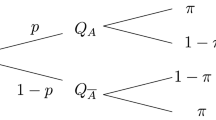Abstract
Randomized response (say, RR) techniques on survey are used for collecting data on sensitive issues while trying to protect the respondents’ privacy. The degree of confidentiality will clearly determine whether or not respondents choose to cooperate. There have been many proposals for privacy measures with very different implications for an optimal model design. These derived measures of protection privacy involve both conditional probabilities of being perceived as belonging to sensitive group, denoted as P(A|yes) and P(A|no). In this paper, we introduce an alternative criterion to measure privacy protection and reconsider and compare some RR models in the light of the efficiency/protection privacy. This measure is known to the respondents before they agree to use the RR model. This measure is helpful for choosing an optimal RR model in practice.
Similar content being viewed by others
References
Anderson H.: Estimation of proportion through randomized response. Int. Stat. Rev. 44, 213–217 (1977)
Fligner M.A., Policello G.E. II, Singh J.: A comparison of two randomized response survey method with consideration for the level of respondent protection. Commun. Stat. A 6, 1511–1524 (1977)
Hong Z.M., Yan Z.Z.: Efficiency comparison of randomized response strategies under the same level of respondent protection. J. Eng. Math. (in Chinese) 25, 97–102 (2008)
Horvitz, D.G., Shah, B.V., Simmons, W.R.: The unrelated question randomized response model. In: Proceedings of the Social Statistics Section, American Statistical Association, pp. 65–72 (1967)
Kuk A.Y.C.: Asking sensitive questions indirectly. Biometrika 77, 436–443 (1990)
Lanke J.: On the degree of protection in randomized interviews. Int. Stat. Rev. 44, 197–203 (1976)
Leysieffer R.W., Warner S.L.: Respondent jeopardy and optimal design in randomized response models. J. Am. Stat. Assoc. 71, 649–656 (1976)
Mangat N.S.: An improved randomized response strategy. J. R. Stat. Soc. B 56, 93–95 (1994)
Mangat N.S., Singh R.: An alternative randomized response procedure. Biometrika 77, 436–438 (1990)
Nayak T.K.: On randomized response surveys for estimating a proportion. Commun. Stat. Theory Methods 23, 3303–3321 (1994)
Warner S.L.: Randomized response: a survey technique for eliminating evasive answer bias. J. Am. Stat. Assoc. 60, 63–69 (1965)
Yan Z.Z., Nie Z.K.: A fair comparison of the randomized response strategies. Acta Mathematica Scientia A (in Chinese) 24, 362–368 (2004)
Author information
Authors and Affiliations
Corresponding author
Rights and permissions
About this article
Cite this article
Zhimin, H., Zaizai, Y. Measure of privacy in randomized response model. Qual Quant 46, 1167–1180 (2012). https://doi.org/10.1007/s11135-012-9698-z
Published:
Issue Date:
DOI: https://doi.org/10.1007/s11135-012-9698-z




